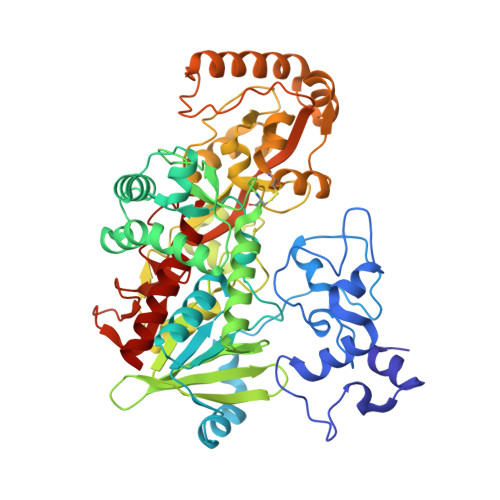Probing Domain Mobility in a Flavocytochrome
Rothery, E.L., Mowat, C.G., Miles, C.S., Mott, S., Walkinshaw, M.D., Reid, G.A., Chapman, S.K.(2004) Biochemistry 42: 4983-4989
- PubMed: 15109257
- DOI: https://doi.org/10.1021/bi030261w
- Primary Citation of Related Structures:
1Q9I - PubMed Abstract:
The crystal structures of various different members of the family of fumarate reductases and succinate dehydrogenases have allowed the identification of a mobile clamp (or capping) domain [e.g., Taylor, P., Pealing, S. L., Reid, G. A., Chapman, S. K., and Walkinshaw, M. D. (1999) Nat. Struct. Biol. 6, 1108-1112], which has been proposed to be involved in regulating accessibility of the active site to substrate. To investigate this, we have constructed the A251C:S430C double mutant form of the soluble flavocytochrome c(3) fumarate reductase from Shewanella frigidimarina, to introduce an interdomain disulfide bond between the FAD-binding and clamp domains of the enzyme, thus restricting relative mobility between the two. Here, we describe the kinetic and crystallographic analysis of this double mutant enzyme. The 1.6 A resolution crystal structure of the A251C:S430C enzyme under oxidizing conditions reveals the formation of a disulfide bond, while Ellman analysis confirms its presence in the enzyme in solution. Kinetic analyses with the enzyme in both the nonbridged (free thiol) and the disulfide-bridged states indicate a slight decrease in the rate of fumarate reduction when the disulfide bridge is present, while solvent-kinetic-isotope studies indicate that in both wild-type and mutant enzymes the reaction is rate limited by proton and/or hydride transfer during catalysis. The limited effects of the inhibition of clamp domain mobility upon the catalytic reaction would indicate that such mobility is not essential for the regulation of substrate access or product release.
Organizational Affiliation:
School of Chemistry, University of Edinburgh, West Mains Road, Edinburgh, EH9 3JJ, United Kingdom.


















